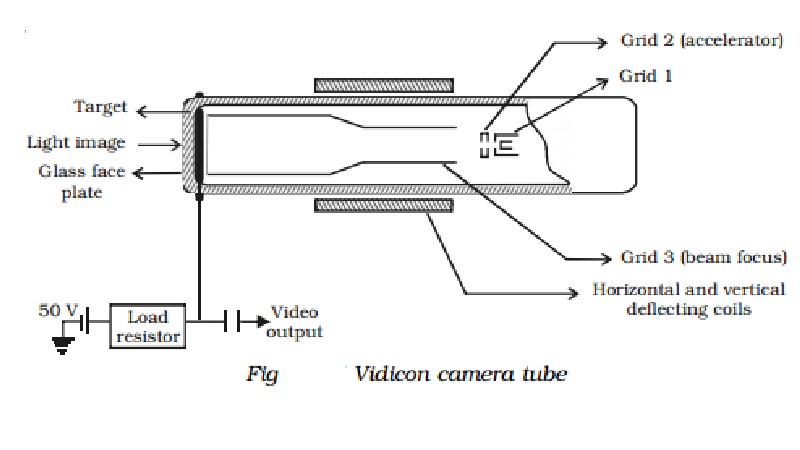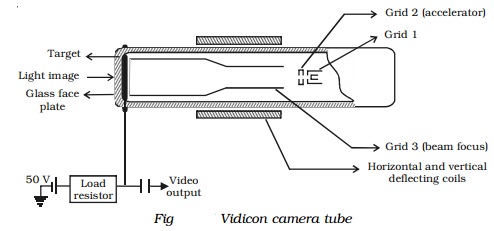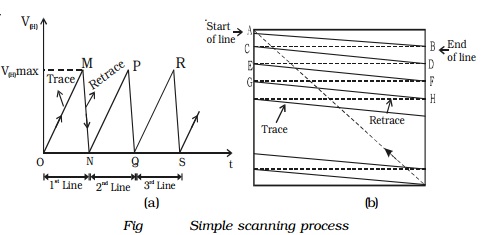Chapter: 11th 12th std standard Class Physics sciense Higher secondary school College Notes
Television: Construction and Working of Vidicon camera tube

Television
Television is one of the marvels
that has been achieved in the field of electronics. 'Television' literally means 'seeing
at a distance.' The principle of television broadcasting is essentially the
same as that of sound broadcasting. In sound broadcasting, sound waves are
converted into equivalent electrical signals using microphone, which are
modulated and transmitted. In picture broadcast (television), the bright and
dark spots of a scene are systematically scanned to produce equivalent
electrical signals. These picture signals are modulated and are then
transmitted. At the receiving end, the picture signals are extracted from the
modulated wave. These are made to reproduce the bright and dark spots of the
original scene on the fluorescent screen of a cathode ray tube called viewing
tube. The sound associated with the scene is transmitted simultaneously to
provide a complete picture and sound reproduction at the receiver. Although the
end result required is a motion picture, television is basically a system for
reproducing a still picture. Many of these are shown one after the other in
rapid sequence during each second, to give the illusion of motion. Therefore,
the first requirement of the television system is that it should be capable of
transmitting and receiving a simple still picture. Usually sound signals are
frequency modulated, while picture signals are amplitude modulated.
1 Vidicon camera tube
Vidicon camera is a television camera which
converts the light energy into electrical energy. It functions on the principle
of photo conductivity, where the resistance of target material decreases when
exposed to light.

Construction
The Vidicon consists of a glass envelope with
an optically flat face plate (Fig ). A photosensitive, target plate is
available on the inner side of the face plate. The target plate has two layers.
To the front, facing the face plate, is a thin layer of tin oxide. This is
transparent to light but electrically conductive. The other side of the target
plate is coated with a semiconductor, photosensitive antimony trisulphide. The
tin oxide layer is connected to a power supply of 50V.
Grid-1 is the electron
gun, consisting a cathode and a control grid. The emitted electrons are
accelerated by Grid-2. The accelerated electrons are focussed on the photo
conductive layer by Grid-3. Vertical and Horizontal deflecting coils, placed
around the tube are used to deflect the electron beam for scanning the target.
Working
The light from a scene is focussed on the
target. Light passes through the face plate and tin oxide, incident on the
photo conductive layer. Due to the variations in the light intensity of the
scene, the resistance of the photo conductive layer varies. The emitted
electrons from antimony trisulphide reach the positive tin oxide layer. So,
each point on the photo conductive layer acquires positive charge. Hence, a
charge image that corresponds to the incident optical image is produced. As the
electron beam from the gun is incident on the charge image, drop in voltage
takes place. As a result, a varying current is produced. This current produces
the video-signal output of the camera.
2 Scanning and synchronising
A still picture is fundamentally an arrangement
of many dark and light areas. Each small area of light or shade is called a
picture element. All the elements contain the visual information in the scene.
If they are transmitted and reproduced in the same degree of light or shade as
original and in proper position, the picture will be reproduced.
In order to produce video signal for all the elements in the picture, it is scanned by the electron beam, one element at a time, in sequential order. The scanning is done in the same way as a written page is read to cover all the words in one line and all lines on the page. Hence, scanning is the process by which an electron beam spot is made to move across a rectangular area, so as to cover it completely. This rectangular area may be the target surface in a television camera or the screen of a picture tube in a television receiver.

The scene is scanned rapidly both in
the horizontal and vertical directions simultaneously. This provides sufficient
number of complete pictures or frames per second to give the illusion of
continuous motion. In most of the television systems, the frame repetition rate
(scanning frequency) is 25 per second.
For scanning the picture elements, saw tooth potentials can
be used. Saw tooth potentials are produced by using a unijunction transistor
and a R-C network. Saw tooth potentials are applied to horizontal and vertical
deflector plates in a TV camera. When the saw tooth potential is applied to the
horizontal plates called line synchronising pulse, the electron beam at A
travels along a slanting line AB by the voltage variation of OM and reaches the
point B (Fig a and b). From B, the scanning spot travels along a line BC
by the voltage variation MN. In order that no picture should be scanned during
the return journey (i.e. the beam from the right horizontal end to the
beginning of the next line), a blanking pulse, which is a high negative
potential, is applied to the control grid of electron gun during the duration
of the return journey. This prevents the emission of electrons from electron
gun. Then the electron beam starts to scan the next line and the process gets
repeated till the whole picture is scanned. On reaching the right bottom
corner, the scanning spot quickly moves up to the top left corner by the
application of saw tooth potential to the vertical deflector plates, called
frame synchronising pulse. Thus for scanning the picture, the three
synchronising pulses are used. These synchronising pulses along with the output
of the TV camera are modulated on an ultra high frequency carrier and
transmitted. The accompanying sound is frequency modulated and transmitted via
the same antenna.
Interlaced scanning
In India, the frame repetition rate
has been standardised at 25 frames per second. This repetition rate is enough
to cause an illusion of continuity. But, the brightness of one frame blends
(mix) smoothly into the next, through this time when the screen is blanked
between successive frames. This results in definite flicker of light, that is
very annoying to the observer, when the screen becomes alternatively bright and
dark. To eliminate this flicker, each frame is scanned twice.
In this scanning, the total number lines are divided into
two groups called fields. During the presentation of the first field, only the
odd numbered lines are scanned, while during the second field all the even
numbered lines are scanned. Half way along the bottom of the first field, the
vertical retrace returns the scanning beam to the top of the image and
completes the unfinished lines. (i.e) The remaining even numbered lines are
then scanned during second field. This method of scanning is known as
interlaced scanning. In the 625 line TV system, for successful interlaced
scanning, the 625 lines of each frame or picture are divided into sets of 312.5
lines and each set is scanned alternatively to cover the entire picture area.
The principle of interlaced scanning is shown in Fig .
Hence, with the interlaced scanning
the flicker effect is eliminated without increasing the speed of scanning,
which in turn does not need any increase in channel bandwidth.
Horizontal and vertical scanning frequencies
The movement of electron beam spot from left to right and
back, so as to start a new line in the same direction is termed as horizontal
scanning. The horizontal scanning frequency is defined as the number of lines
scanned per second. In a 625 line system, transmitting 25 frames per second,
the horizontal frequency is 625 × 25 = 15,625 Hz.
Consequently, time taken to scan one line is 15,625 =
1/64 µs
Vertical scanning is the movement of the electron beam spot
in the vertical direction. One frame consists of two fields, resulting into 50
fields per second with a vertical field scan time of 1/50=20ms.
Related Topics